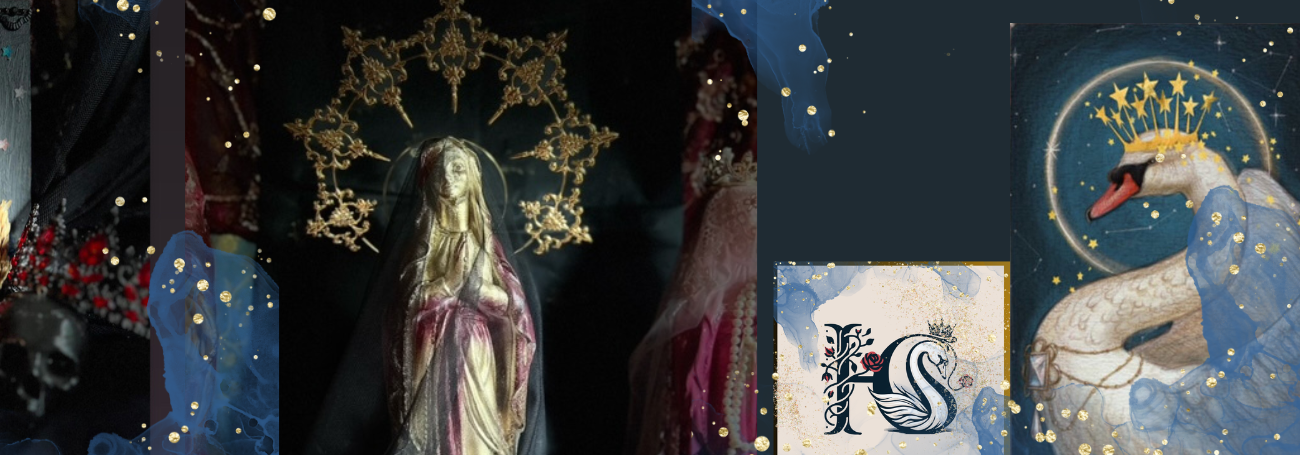Om Mani Padme Hum – the Mantra of Christ
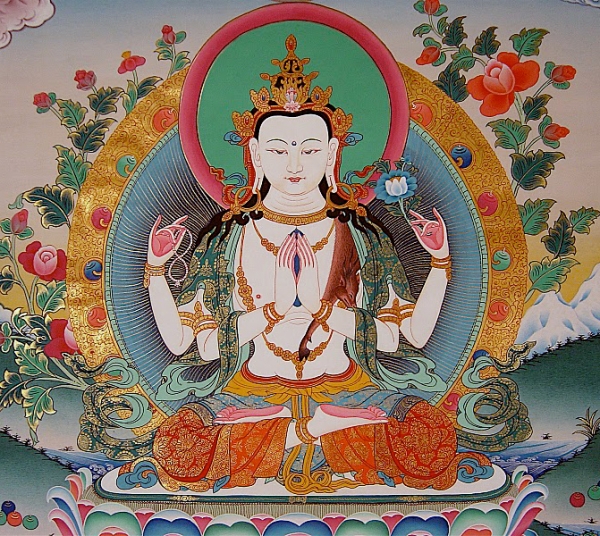
(The information is extracted from Gnostic teachings)
In every religion, in every tradition, there is always a foundation or presentation of a universal cosmic force at the base of life. That force or energy has different names according to the languages and psychologies of those various traditions, names like Allah, Tao, Brahma, Quetzalcoatl, and many more. In the Gnostic tradition, we call it Christ.
The word Christ comes from the Greek root Christos (Χριστός), which has different meanings depending on the context within which we use the word. The esoteric meaning of the word Chrestos is fire, which refers not to physical fire, but to the foundational energy that gives rise to all living things. Christ is the source of life, the source of living.
Everything that exists is the body of Christ; every atom, every particle, every energy, has that force or energy that we call Christ. Every religion and spiritual tradition has its own names, symbols, and myths about that energy, which help us to understand that energy, because as the very basis of living, it is very difficult to comprehend. Our mind is very limited in its capacity to understand the infinite, which is what Christ is. Christ is infinite life.
In the Sanskrit language, that force at the level at which it first emerges into existence is called Amitabha, which means infinite light. Thus it is called the Buddha Amitabha: which translated directly, means “the awakened limitless light,” or infinite light. That light is the fire of Chrestos; it is not physical light, or physical fire, it is the light or fire of existence itself.

Amitabha
In Kabbalah, that infinite light or limitless light is called Ain Soph Aur, which also means limitless light. So, in these three traditions are three different names for the same energy.
This painting shows the Buddha Chenrezig, which is a Tibetan word that is indicating the same energy. Chenrezig in Sanskrit is called Avalokiteshvara.
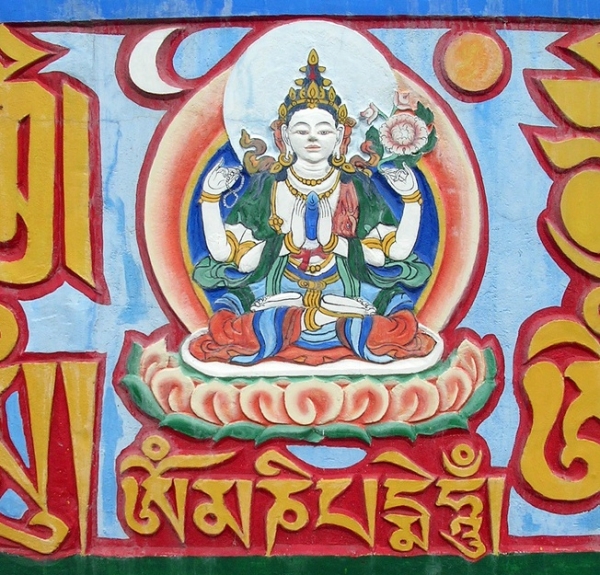
Avalokiteshvara or Chenrezig represents the full and complete compassion of Christ that manifests in existence. When the Ain Soph Aur first becomes, it is Chenrezig, Avalokiteshvara. It is the compassion of all the Gods. Chenrezig, or Avalokiteshvara is the love in every Buddha or Angel; all of them combined are Chenrezig, Avalokiteshvara, Christ. So, if you use your imagination and try to visualize all of the Buddhas in the entire field of existence, all of the Angels, all of the Masters, all of the Devas, all of the Gods, and how much love they have, all of that love is Chenrezig, Avalokiteshvara.
This image shows Chenrezig sitting on a lotus, and that lotus sits on a mantra. That mantra on this graphic is written in Tibetan, and the mantra is Om Manipadme Hum. Those Sanskrit letters are written here in Tibetan, because that mantra is the special providence of the protector deity of Tibet, who is Chenrezig, Avalokiteshvara. So, this is our topic for today: Om Manipadme Hum – to understand what that is, what it means, what is Christ, and how they relate.
The Six-syllable Mantra
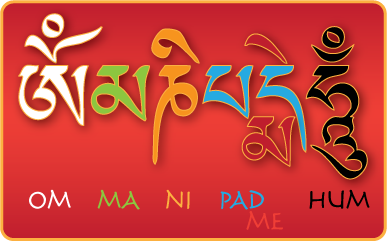
Om Manipadme Hum: these are the letters of this mantra. It has six letters, and in this graphic you see that each one has a different color. The colors are symbolic and important. We see here five primary colors that are important in all Buddhism: yellow, green, white, blue, and red. The five colors relate to five elements. They also relate to five afflictions, the five poisons, and other aspects of the teachings. The sixth color, which in this particular image is a dark blue, also can be black. The six colors relate to the six worlds, the six bardos, the six paramitas, the six types of beings, and more. They have very deep significance.
These are Tibetan letters, six syllables; each one has importance and meaning. They start from left to right, just like English.
The first one, which is white, is Om. The letter Om is a mantra from Sanskrit, from Hinduism. Om sounds like one sound, but it is actually three sounds, and in the Tibetan letter we can see those three components very clearly. I will come back to that to explain more about the Om.
The second letter, which is green, is Ma. The third, which is yellow, is Ni. The fourth is blue, Pad, which is actually two letters, but one syllable. The fifth, is Me, which is written enclosing the Pad. The final is Hum, which is black.
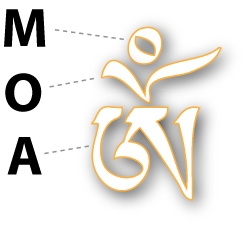 The mantra begins with Om, and that letter has three components, which relate to the three forces, the Trikaya, the Trinity. The bottom portion, the largest part, is the Tibetan letter Ah. It is the Tibetan equivalent of what is known in Hebrew Kabbalah as Kether, the Father, the Crown. Just above that Ah is a dashed line, which represents the letter O. This relates to Chokmah in Kabbalah. At the very top is the Tibetan letter M, which is written as a circle; incidentally, in Hebrew and in Sanskrit, the M is written as an enclosed shape, a circle or square. The same is true in Tibetan. Thus, the the syllable Om has three parts. We often write the mantra long form as AOM or AUM.
The mantra begins with Om, and that letter has three components, which relate to the three forces, the Trikaya, the Trinity. The bottom portion, the largest part, is the Tibetan letter Ah. It is the Tibetan equivalent of what is known in Hebrew Kabbalah as Kether, the Father, the Crown. Just above that Ah is a dashed line, which represents the letter O. This relates to Chokmah in Kabbalah. At the very top is the Tibetan letter M, which is written as a circle; incidentally, in Hebrew and in Sanskrit, the M is written as an enclosed shape, a circle or square. The same is true in Tibetan. Thus, the the syllable Om has three parts. We often write the mantra long form as AOM or AUM.You may have heard that the vowel or mantra Om is the most important mantra. This is because this mantra encodes or symbolizes Christ. Christ has three forces that work in harmony to create. All life emerges as a result of the power of creation, and creation is always a combination of three factors. This is why every religion has a trinity as its foundation. Christianity has the Father, the Son and the Holy Spirit. Hinduism has Brahma, Vishnu, and Shiva. Kabbalah has Kether, Chokmah, and Binah. The Egyptians had Osiris, Isis, and Horus. In every religion—the Nordic, the Egyptian, even in Masonry—we find those factors, three forces. In the Gnostic tradition, we call them the Logos. This is because, in the book of John in the Christian Bible, it says:
In the beginning was the Logos.
The book of John is written in Greek. The word Logos is Greek, and is usually translated as “word.” In scripture, Logos does not refer to a written or physical word. Logos refers to the sound that emerges from the emptiness. If we consider a thought as a concept or message that is unmanifested, when we speak it, the word that emerges is logos. Similarly, the Logos is the expression or manifestation of a message or intelligence. In other words, the emptiness or Unmanifested Light had the impulse of creation, an archetype that needed to become something, and when that archetype expresses and starts to become something, that is Logos. So, in Buddhism, this is represented by Amitabha, the infinite light, manifesting Chenrezig out of compassion for all beings. The infinite light, Amitabha, sees the suffering of all beings, and recognizes the need to do something, thus Chenrezig appears; that is the Logos: the Manifested Light.
The Logos is a trinity, a unity of three forces:
Positive
Negative
Neutral
In any form of creation, there are three forces at work. For example, for you to have your physical body, you two parents had sex. Your father represents the positive or active force, your mother represents the receptive or passive force, and sex is the force that unified them. Your body was the result.
Om represents the creative (sexual) power of nature. Om represents the manifestation of the Absolute, it is the vibration of Creation: three forces in motion. We say “Om,” but hidden in that are three sounds: A-O-M.
When we look at that more closely on the Tree of Life, we see at the very top of the Tree of Life, the Absolute, Amitabha, the infinite light that first emanates as the upper Trinity on the Tree of Life. That Trinity is the three forces that begin to create all living things – in other words, manifestation begins. What does that imply? It implies a change from the Absolute Primordial Emptiness, to something. That happens because of Karma. It happens because of causes that have been put into motion in the past, that must be answered. It happens because all of us have setup causes in the past that have to be solved, and it happens because the infinite light seeks to perfect compassion, through us. The only way that can happen, is if we are here, alive, with the chance to act, using those energies of the three forces in ourselves. Those energies of the three forces come through us in many ways – we have three nervous systems: the central, sympathetic and grand sympathetic. We have three brains: Intellect, Heart and Body. We need to use those three forces in every motion of ourselves, physically, emotionally and mentally, but consciously. In order to take advantage of those forces, and use them in manifestation wisely. So, what we see then, is Om here, at the top of the Tree of Life. If we superimpose this graphic over our physical body, the feet are related with Malkuth, at the bottom. The top of the head, with Kether at the top. So, that Om vibrates from the Infinite above, throughout our entire being. Those three sounds synthesized in that mantra, create everything, including ourselves. So, the use of that mantra is quite powerful. This is the breakdown of this specific meanings of these words.
Mani, which is the second set of syllables, Ma and Ni, means:
stone
jewel
anything round
phallus
clitoris
Mani comes from the root Sanskrit term, Ma, which means “to create.”
It is quite obvious that all the meanings of this word are all related. What in our body is the strongest magnetic force that we have? Sex, there is nothing stronger in us than that power. The sexual power is the power to create, and it is a magnet, which can attract or repel. That magnet is most powerful in the sexual organs, and it is the power of Ma, the Mother.
The syllable Ma is used worldwide for Mother: Ma, Amma, Uma, Oma, Mama, Mother, Mater.
In Sanskrit, Ma means “to create.” Who has that power? The Mother. How does the Mother have the power to create? Through sex. There is no other way. As we always state, in every esoteric tradition:
As Above, So Below, and As Below, So Above.
If, physically, the only way to create life is through sex, it is also true above, spiritually. The only way to create spiritual life, is through sex, but as Chenrezig shows it: holding the Mani stone, as a prayer, at his heart. This is the only way to create in harmony with the Divine, through prayerful, pure, sexuality.
The second set of syllables, Padme, means lotus, but it also is a symbol for the vagina. This is a very obvious symbol that most people, especially who have studied art history, know very well; throughout the centuries and in pretty much every culture, flowers have been used to represent feminine sexual potency, even as late as the recent century with artist like George O’Keeffe. But, in previous eras, throughout time, and in every culture, flowers represent the unfolding of creation which happens through the vagina. The child is created through that.
The final syllable is Hum. This is the syllable that is represented with the color black. Hum synthesizes the entire mantra. Hum sounds like Om. It is almost the same, but it has an H. The H is mantra of the breath. The Logos is the thought, the imagination of God that comes into being through a word, and that word can only express through breath. This is why the Aztec priests, when they were asked by the Conquistador priests, “What is the name of your God?” the Aztec priests said, “Hhhhhhhhhhhhhhh.” It is the power of the breath that creates through the Word.
So, here in these six syllables – Om Ma Ni Pad Me Hum – we see the creative power of God, the creative power of any Buddha, which is sexual, which is why every religion has emphasized the importance of pure sexuality and has told its strongest initiates that to advance to the highest levels of the tradition, you must retain that sexual energy and transform it. Not to spend it like a beast, not be lustful, but to harness that energy and make it pure. This is why initiates in traditions were converted into monks and nuns, to enter into a period of preparation in which they retained that energy, were not hypnotized by any form of lust or distraction sexually, and could learn to work with that energy directly, until the time came when they were prepared to enter into a relationship to fully harness that energy. This is hidden throughout the Bible, it is hidden throughout Tantra. It was never made public, and that is because most of us have never been interested, we have only been interested in satisfying our desires. In these six syllables is the synthesis of the entire teaching. Any real spiritual teaching, anywhere in the world, has this synthesis in its heart. It may not be visible now, because of degeneration, because of politics, because of the interest that people have to corrupt their traditions and take power, but it is always there, hidden.
The Jewel in the Lotus
most people say that Om Manipadme Hum means “the Jewel in the Lotus.” That is because Mani can mean jewel, and Padme can mean lotus, but nobody knows why the mantra has that meaning. Why would it be important to have a mantra that means “the Jewel in the Lotus?” Why is that meaningful? Why is that the most important mantra in Tibetan Buddhism? Publicly, no one knows, because they have not been initiated into the levels where that knowledge is given. I am going to give you some of that knowledge today.
These syllables have meanings far deeper than the surface level, but even if you look at the superficial level, you can see something very deep. Mani represents the masculine sexual power, a phallus. Padme represents the vagina. The power to create life is in the union of these two, the crossing of male and female. When that union happens in a pure way, without lust or animal desire, when Mani and Padme unite between the Om and the Hum, the result is a divine creative power. That is why “the Jewel in the Lotus” is important, but this meaning has not taught publicly until recently.
Chenrezig Gyalwa Gyatso
The deeper level of this mantra is taught in secret, and it is related to the secret level of the teachings of Chenrezig, which are that level called Chenrezig Gyalwa Gyatso. Here we see an image of this level of Chenrezig: He is in his white bodied form, but in sexual union with his consort, his spouse, who is called Vajrayogini. Chenrezig Gyalwa Gyatso is a Tibetan name that is difficult to translate to English, but it means something more or less like, “The ocean of liberation” or “The Saviour Ocean.” It is hard to translate that into English, because those Tibetan words have very deep significance.
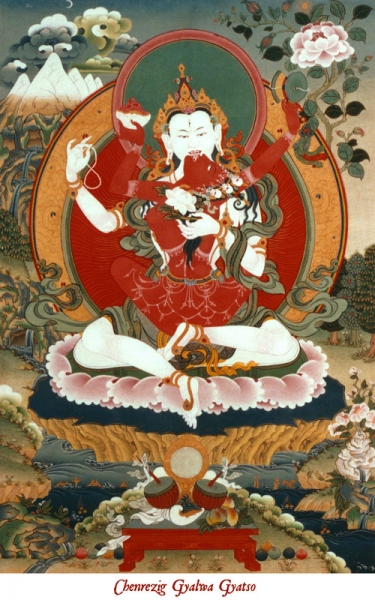
Clearly, you can see that Chenrezig relates to sexual knowledge. Yet, monks and nuns of the Tibetan tradition are not initiated into the secret aspect of Chenrezig Gyalwa Gyatso. So, if you go and ask a monk or nun about the sexual teachings related to Chenrezig Gyalwa Gyatso, they might get mad or offended. This happened to a friend of mine, that is why I am telling you. We have to be respectful of the level at which every student is working. Do not assume that other people know what you know. We have to respect their level, and the work that they are doing. Chenrezig Gyalwa Gyatso is the highest Yoga Tantra in Tibetan Buddhism, it is one of the most secret techniques and teachings that is given in Tibetan Buddhism. It is secret knowledge. This means that the vast majority of people in the Tibetan tradition do not know about it. Even though some people may have received an empowerment or lecture about Chenrezig Gyalwa Gyatso, this does not mean they received the secret teachings of Chenrezig Gyalwa Gyatso. This means that if you know about the secret aspect of Chenrezig Gyalwa Gyatso, you should be respectful about it to others when discussing it, or asking about it. Be aware that they may not know.
Nonetheless, in this image we can see Chenrezig in the male form, united with Chenrezig in the female form. One is white and the other red. In Tantric iconography, white and red represent solar and lunar forces, what is known in Sanksrit as Ida and Pingala, while in the Bible they are Adam and Eve, male and female, the two aspects of our vital energy. In other words, this image does not just represent a Deity; it does represent a divine being, but its most important meaning is inside of us, related to our own energies on a very high level, energies that we can learn to harness and utilize. This image represents the creative and destructive power of sexuality.
